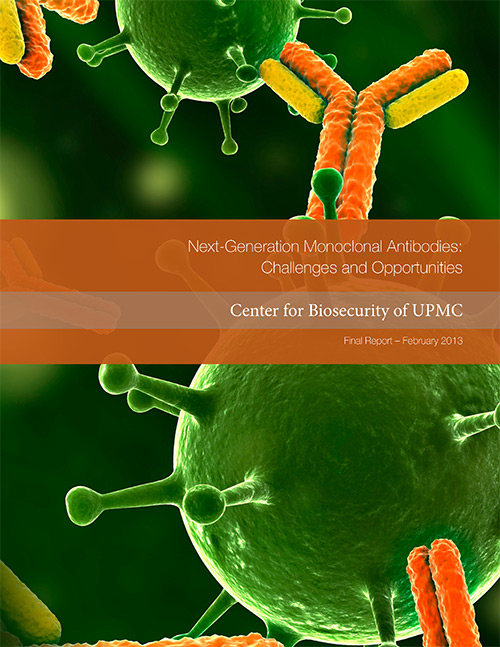Our publications keep professionals working across the public, private, and academic sectors informed on the most important developments and issues in health security and biosecurity.
Find an article or report by keywords:

Center for Biosecurity of UPMC, February 15, 2013
The Center for Biosecurity of UPMC conducted this study to provide leaders in the US Department of Defense (DOD) with an expert assessment of the technical feasibility and strategic implications of next-generation monoclonal antibodies (mAbs) as medical countermeasures (MCMs) for DOD personnel. Our assessment includes identification of potentially appropriate DOD investments in mAb technologies.
Monoclonal antibodies have great potential usefulness to counter biological warfare agents and naturally occurring infectious disease threats that are not addressed by currently available countermeasures. Monoclonals display exquisite specificity, are able to recruit additional host immune components to fight infection, confer near-immediate immunity once administered, can be successfully administered to all populations regardless of current immune status, and have a generally low rate of adverse reactions. Further, mAbs may offer pre- and postexposure protection in addition to potential therapeutic benefits, even in the case of antibiotic resistance. There is also a body of scientific evidence that mAbs may be effective in treating disease caused by biological warfare and natural pathogens of concern to DOD.
Monoclonal antibodies have become a commercial blockbuster drug platform, with the biggest portion of sales growth in the pharmaceutical industry. However, the concentrated effort in monoclonal antibody development has focused on oncological indications and immunological diseases, such as rheumatoid arthritis (RA). There is one commonly used licensed product for prevention of respiratory syncytial virus (RSV) in premature babies, another recently FDA approved for inhalational anthrax disease, and a handful of mAb products undergoing clinical evaluation for infectious disease indications, including methicillin-resistant Staphylococcus aureus and Clostridium difficile.
In spite of the lack of commercial attention to infectious disease mAbs, there are a number of reasons to believe they may be more desirable in the future, because of the declining clinical effectiveness of antibiotics; the large number of immunocompromised people who could benefit from mAbs; the growing recognition of the microbiome, which is disrupted by antibiotics; and the increased availability of diagnostic tests that may make mAbs more feasible to administer. In addition, because many infectious disease indications may require administration of a cocktail of mAbs, it is encouraging that the FDA has allowed cocktails of mAbs to be clinically tested as one product.
Monoclonal antibodies are expensive. As a biologic class of drugs, they cost more to manufacture than small-molecule drugs, and FDA-licensed mAbs are currently among the most expensive drugs for patients and insurance companies. Many factors contribute to the cost of a particular mAb, but the most important factor influencing their price appears to be the market—the market will bear a high cost for mAbs, so they carry a big price tag. Some indicators suggest the cost of mAbs is dropping; this has been attributed to insurance company actions and greater mAb manufacturing standardization.
Monoclonal antibodies, in general, do not carry as much regulatory risk as other medical countermeasures, and the FDA has recent and historical experience with evaluating mAb products. This makes mAbs especially attractive for DOD, which is required to use only FDA-approved MCMs for prevention and treatment. However, biodefense products in general are riskier than other MCMs because they often require application of the FDA Animal Efficacy Rule, which allows for FDA approval based on animal model efficacy data and human safety data.
As a class, mAbs will not replace vaccines or drugs in a complex MCM strategy, but they can be an important adjunct of a comprehensive approach that may be well-suited for specific DOD populations and for specific pathogens. Therefore, the question confronting DOD is not whether mAbs should be employed, but how to use mAbs technologies effectively. This report recommends that DOD take the following actions to take advantage of mAb technologies: